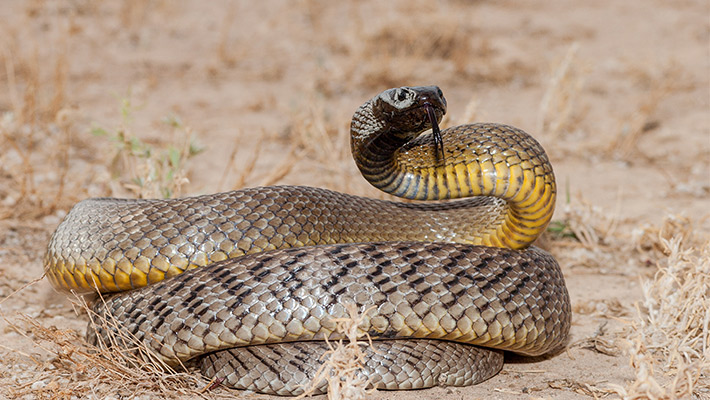Learn about the Inland Taipans
Scientific name: Oxyuranus microlepidotus
Conservation status: Least concern
Distribution: South-western Queensland and north-east and central South Australia
Environmental Threats: Competition with cats and foxes, ecosystem modification, climate change
Lifespan: 10-15 years
Clutch size: 12-20 eggs
Incubation: 66 days
Size: Around 200cm long
What do Inland Taipans eat?
Taipans are unique amongst Australia’s elapid snakes as the only species to feed exclusively on mammals. Inland Taipans feed on introduced mice, native rats, and small marsupials such as carnivorous Dasyurids. Long-haired Rats which go through large seasonal fluctuations are a primary prey item.
World’s Most Venomous Snake
The Inland Taipan’s venom is the world’s most venomous, with a single bite capable of killing around 200,000 mice. It is believed that the high potency of their venom has evolved for as specialisation for eating dangerous mammals. The venom acts quickly to kill the prey before they can bite back or escape.
What is the difference between Venom and Poison?
Venom is a toxin that is injected into the prey’s body, such as with sharp fangs, whilst poison is a toxin that acts when ingested or swallowed. This is why snakes like the Inland Taipan are considered venomous, whereas frogs like the Corroboree Frog are called poisonous.
Fierce Snake or Shy Serpent?
Sometimes called a Fierce Snake for their deadly bite, their behaviour is anything but. They are a shy and placid snake around people and will only ever bite people when threatened. Living in remote regions, they are rarely seen by people. Only a handful of bites have ever been recorded, with no fatalities. Like all snakes, if seen they are best left alone and observed from a safe distance.
Colour-changing Chameleon
Though less extreme as what may be seen amongst lizards, this snake undergoes annual colour changes with the seasons. They are a dark colour in Winter which allows more heat absorption, and fade to a lighter colour in Summer.
Are Inland Taipans Threatened?
This species has disappeared from parts of its historic range, likely including NSW, however is currently classed as Least Concern. As mammal-specialists, taipans have been less affected by the spread of poisonous Cane Toads across Australia than other snakes. Their specialisation in mammals however makes them dependent on prey availability, which has been reduced in areas by cats and foxes. They have also been assessed as highly vulnerable to the future impacts of climate change on the Australian landscape.
